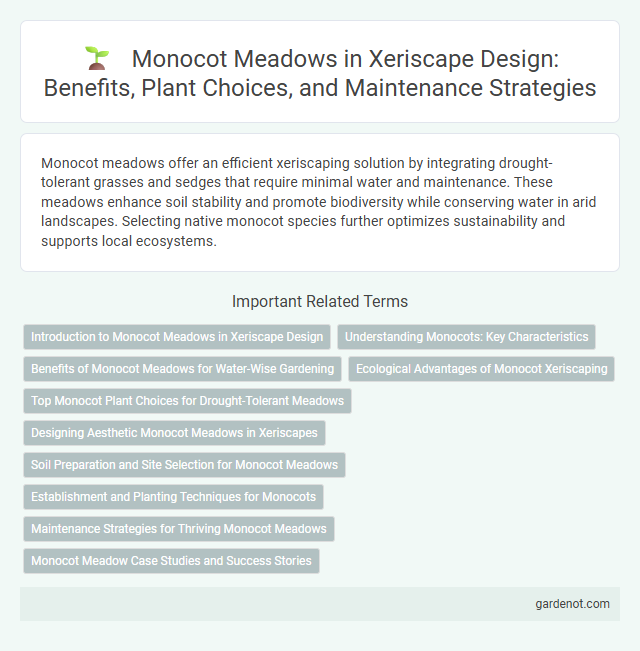Monocot meadows offer an efficient xeriscaping solution by integrating drought-tolerant grasses and sedges that require minimal water and maintenance. These meadows enhance soil stability and promote biodiversity while conserving water in arid landscapes. Selecting native monocot species further optimizes sustainability and supports local ecosystems.
Introduction to Monocot Meadows in Xeriscape Design
Monocot meadows in xeriscape design emphasize water-efficient landscapes by integrating drought-tolerant grasses and sedges such as blue grama, buffalo grass, and carex species. These perennial monocots provide sustainable ground cover that reduces irrigation needs, enhances soil stability, and supports local biodiversity. Utilizing monocot meadows promotes ecological balance while maintaining aesthetic appeal in arid and semi-arid environments.
Understanding Monocots: Key Characteristics
Monocot meadows thrive due to the distinctive features of monocots, which include parallel leaf venation, fibrous root systems, and flower parts typically in multiples of three. These key characteristics enable efficient water absorption and drought resistance, making monocots ideal for xeriscape landscapes. Understanding monocots' adaptive traits supports successful cultivation of low-water-use gardens focused on sustainability and biodiversity.
Benefits of Monocot Meadows for Water-Wise Gardening
Monocot meadows, composed primarily of grass and sedge species, enhance water-wise gardening by significantly reducing irrigation needs due to their deep, efficient root systems. These plants improve soil structure and increase water retention, minimizing runoff and promoting sustainable landscape health. Their drought tolerance and low maintenance requirements make monocot meadows an eco-friendly solution for conserving water in xeriscape gardens.
Ecological Advantages of Monocot Xeriscaping
Monocot xeriscaping promotes water conservation by utilizing drought-tolerant grasses and sedges that thrive in low-moisture environments, reducing irrigation needs. These native monocots support local biodiversity, providing habitat and food sources for pollinators and soil organisms. Their deep root systems enhance soil stability and carbon sequestration, contributing to healthier, more resilient ecosystems.
Top Monocot Plant Choices for Drought-Tolerant Meadows
Top monocot plant choices for drought-tolerant meadows include native grasses such as Blue Grama (Bouteloua gracilis), Little Bluestem (Schizachyrium scoparium), and Big Bluestem (Andropogon gerardii), renowned for their deep root systems and low water requirements. These species provide excellent soil stabilization and support local biodiversity while thriving in xeric conditions. Incorporating perennial sedges like Carex pensylvanica enhances texture diversity and drought resilience in monocot meadows.
Designing Aesthetic Monocot Meadows in Xeriscapes
Designing aesthetic monocot meadows in xeriscapes involves selecting drought-tolerant grasses like blue grama, muhly grass, and fountain grass that provide texture and movement while minimizing water use. Incorporating varied heights and colors enhances visual interest and supports native pollinators, promoting biodiversity within low-water landscapes. Strategic placement of monocots in clusters or drifts creates naturalistic patterns that blend seamlessly with desert-adapted shrubs and succulents.
Soil Preparation and Site Selection for Monocot Meadows
Optimal soil preparation for monocot meadows involves well-drained, nutrient-poor soils with a slightly acidic to neutral pH, promoting native grass and sedge growth while minimizing invasive species. Site selection should favor areas with full sun exposure and minimal foot traffic to support robust root development and water-efficient plant communities. Incorporating organic matter enhances soil structure and moisture retention, essential for sustaining drought-tolerant monocot species in xeriscape designs.
Establishment and Planting Techniques for Monocots
Establishing a monocot meadow requires well-prepared, well-drained soil with minimal competition from weeds for optimal root development. Planting techniques include sowing seeds or transplanting plugs during early spring or fall to take advantage of cooler, wetter conditions that improve germination and establishment rates. Regular, moderate watering combined with mulch application helps retain moisture and supports young monocots until they become self-sufficient.
Maintenance Strategies for Thriving Monocot Meadows
Effective maintenance strategies for thriving monocot meadows focus on optimizing water efficiency and soil health through careful irrigation scheduling and minimal disturbance practices. Regular monitoring of plant health and targeted weed control prevent competition, while periodic mowing or selective trimming supports dense growth and enhances biodiversity. Incorporating organic mulch and adjusting soil amendments promote nutrient availability, helping sustain vigorous monocot populations in xeriscape environments.
Monocot Meadow Case Studies and Success Stories
Monocot Meadow showcases successful xeriscape case studies emphasizing drought-tolerant monocot plants such as native grasses, sedges, and rushes that thrive in low-water environments. These projects highlight significant water savings, biodiversity enhancement, and reduced maintenance costs, demonstrating the effectiveness of xeriscaping principles. Documented success stories from urban and residential landscapes illustrate how Monocot Meadows create sustainable, aesthetically pleasing spaces adapted to arid climates.
Monocot meadow Infographic

 gardenot.com
gardenot.com